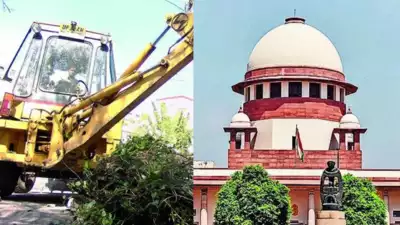
NEW DELHI: The Supreme Court on Wednesday laid down strict norms to curb the bulldozing of justice adopted by some states and said the executive branch “cannot become a judge and demolish the houses of the accused”. The statement said action would be taken against public officials who acted “in a high-handed manner”.
It added that if the houses of the accused or criminals were demolished without following legal procedures, their families would be entitled to compensation.
It ruled that a mandatory 15-day notice must be given to the occupants of an allegedly illegal structure before it can be demolished. If the owner fails to dispute or respond to the notice, the state will be allowed to proceed with the demolition, but only if the entire process is videotaped, the report said.
The article stated that public officials who “take the law into their hands” and act “highly” must be held accountable.
A bench headed by Justices BR Gavai and KV Vishwanathan noted, “The rule of law provides the framework to ensure that individuals know that property will not be taken away arbitrarily.”
“The administrative agency cannot declare a person guilty. If his house is demolished solely on the basis of charges, it will go against the fundamental principles of the rule of law. The administrative agency cannot become a judge and decide to demolish the property of the accused,” the bench said.
The Supreme Court stayed its October 1 order and extended the interim order to prevent demolition of any property without permission until further notice. However, the interim order does not apply to unauthorized construction, including religious structures constructed on roads, sidewalks and similar areas.
The Supreme Council said India is a secular country and clarified that its directives on demolition of properties will apply equally to all religions. The court made it clear that demolitions cannot be carried out solely on the basis that an individual has been charged or convicted.
The court is hearing various petitions regarding the authorities’ use of bulldozers to demolish the properties. It specifically noted that minority and marginalized communities were disproportionately affected by these demolitions, creating a disturbing precedent for these communities and the public.







